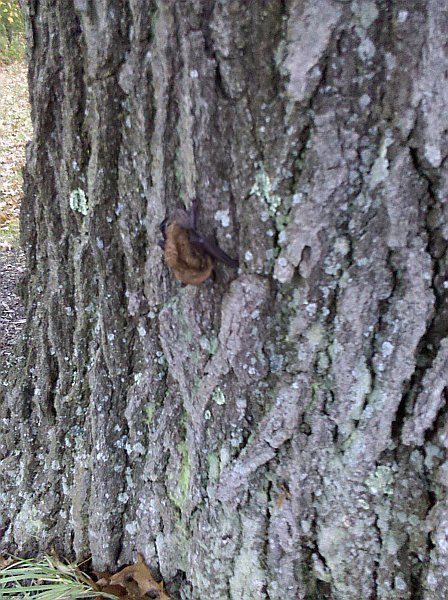
While walking home in the rain last night I saw a brown lump on an oak tree in Schenley Park.
Only a foot off the ground and smaller than the palm of my hand I thought it was a mushroom — until I got close.
It was a little brown bat and he was sleeping.
Without any experience in identifying bats my guess is that he was the most common bat in Pennsylvania, quite literally a “little brown bat,” Myotis lucifugus, whose scientific name means “mouse-ear light-fleeing.”
I didn’t want to wake him so I held my umbrella over my cell phone and took his picture from three feet away.
Even in this distant photo you can see his folded wing on the right and his tiny brown ears pointing down. Remember, he’s upside down so his ears are at the bottom. Click here to see what this species looks like up close.
Since bats eat flying insects their food supply disappears during Pennsylvania winters so they must hibernate or migrate to survive. This little guy has spent the last few months fattening up and mating in preparation for hibernation. Soon he will adjourn to a damp cave or abandoned mine shaft to hibernate with his fellows in a place that stays above freezing.
Interestingly, if this one is female she will store the male’s sperm in her uterus all winter, fertilize one egg in the spring and give birth to a single baby in late May or early June.
But that’s a long way down the road. Halloween is over. It’s time to find a cave.
I don’t expect to see this bat on the oak tree today. But I will check.
(photo by Kate St. John)
.
UPDATE Nov 1: Alas! The bat was there this morning. He’s dead, though I didn’t touch him to make sure. Theory: He’s perched right next to a busy road. Perhaps he was hit by a car and still mobile enough to roost but too injured to live. Alas!
UPDATE Nov 2: I saw a bat flying in Schenley Park this evening. Maybe my bat still lives!
UPDATE Nov 4: I saw a bat flying in Greenfield tonight at dusk. I never noticed them this late before.
Kate – Am I wrong in thinking that – like some birds – the bat’s feet are in the “clenched” position, when they’re asleep? Or do they just sleep *that* lightly?
I know their feet can cling when they hibernate — which is very deep sleep — so my guess is that they must naturally clench. (See my update on the blog… still clinging to the tree, though dead.)
I’d like to think he just died peacefully in his sleep of old age.
. . . while dreaming of harassing swarms of mosquitoes. 😉